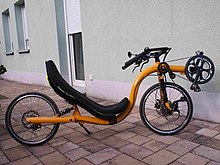Low-flying
Lowracer (engl. Lowracer ) and Semi-lowracer are recumbent cycles with a particularly low seat height.
The lowest point of the seat is usually less than 35 cm above the road, so that the driver can support himself with his hand on the floor in a normal sitting position and does not have to take his feet off the pedals. Low-flying planes are primarily used for rapid movement. The low sitting position and the crank at head height allow a particularly small frontal area , which reduces air resistance. Moderate variants with a seat height of 35 to 45 centimeters are called semi-low-flyers .
Geometry and variations
What most low-flyers have in common is the bottom bracket attached right at the front , so that low -flyers are short-lived . The bottom bracket is often positioned significantly higher than the seat. The difference in height is known as the bottom bracket elevation . The legs are in front of the body instead of largely below the body, which reduces the frontal area and results in good aerodynamics. A strong bottom bracket elevation ensures that the hips are bent, which, according to reports from many recumbent cyclists, means good ergonomics . The hips are also bent when riding a racing bike, but not because of raised legs, but because of a bent upper body. The disadvantage of the bottom bracket elevation is an impaired view to the front. Semi-low-flyers, which have a lower bottom bracket elevation due to the slightly higher seating position, therefore offer a better view to the front. The handlebar is above the fork in low-flying aircraft. As a result - in contrast to the lower steering - the arms are in front of the body instead of underneath, which improves aerodynamics and increases the lean angle.
Although all low-flyers and semi-low-flyers have a similar geometry, there are numerous design differences between the individual models. One finds:
- different wheel sizes, especially at the rear (mostly 20 inches at the front)
- Front or rear wheel drive
- Different seat back angles: A flat angle (often less than 25 ° to the horizontal) is used for aerodynamics, a steep seat angle (up to 45 °) is used for optimized ergonomics and force transmission into the crank. B. in the illustrated ZOX 20 Z combined with extremely low seat height and front-wheel drive
- Low-flyers optimized for racing use with carbon frames and fork, as well as variants suitable for everyday use with suspension, light and luggage rack
- Rear panels, which improve the aerodynamics and u. U. provide space for luggage
- Tiller handlebar (from English : Tiller = boom), which is located directly in front of the body and is operated with sharply bent elbows or around-the-knee handlebars that are operated with straight arms.
Classic low-flying aircraft with steel or aluminum frames weigh between 10 and 18 kg. Ultralight models are located at 8 kg.
practice
The concept combines characteristics typical of recumbents, such as high comfort, straight forward visibility due to the relaxed head position and increased safety, especially for the driver's head, with good aerodynamics , very short braking distances and excellent handling in curves due to the low center of gravity .
As with all recumbent bicycles, you cannot pedal out of the saddle , which means that low-flyers tend to climb slightly more slowly - but also due to the generally slightly higher weight compared to normal racing bikes. Corresponding driver performance and development provided the gear shift, however, they are also quite suitable alps. On the flat and downhill, a low-flyer shows its advantages because of the smaller frontal area. The great convenience of a recumbent bike is an advantage for cycling marathons or long bike tours .
Many experienced recumbent riders do not consider the danger posed by cars as opposed to recumbent bikes compared to racing bikes. The disadvantage of the smaller silhouette, it is assumed, is compensated for by the fact that, as a result of the relaxed, upright posture of the head, the driver's eyes and thus the driver's perception are always automatically directed forward. In addition, there may be a rear-view mirror attached to the handlebar (top handlebar) close to the line of sight to the front, so that the driver can also keep an eye on the traffic behind.
Typical models
Rear wheel drive
- Optima Baron
- M5 low racers
- Velokraft VK2
- Flux Z-Pro
- zephyr
- Challenge Fujin, Jester
- Velokraft NoCom (ultra low-flyer)
- Speedster FS (everyday racing bike)
- TROYTEC Revolution (high tech carbon low-flyer)
- Challenge Hurricane (semi-low-flyer)
- Nazca Fuego (Semi)
- HP Velotechnik Speedmachine (semi-low plane)
- Flux S-Comp (semi-low-flyer)
Front wheel drive
- Zox 20 Z (picture 1)
- Toxy ZR (pic 3)
- Barcroft Oregon
- RaptoBike Low Racer


